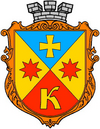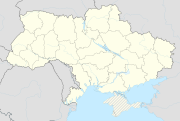Kobeljaky
| Kobeljaky | ||
| Кобеляки | ||

|
|
|
| Basic data | ||
|---|---|---|
| Oblast : | Poltava Oblast | |
| Rajon : | Kobeljaky district | |
| Height : | 72 m | |
| Area : | 1.21 km² | |
| Residents : | 9,927 (2017) | |
| Population density : | 8,204 inhabitants per km² | |
| Postcodes : | 39200 | |
| Area code : | +380 5358 | |
| Geographic location : | 49 ° 8 ′ N , 34 ° 12 ′ E | |
| KOATUU : | 5321810100 | |
| Administrative structure : | 1 city | |
| Address: | вул. Касьяна 29 39200 м. Кобеляки |
|
| Statistical information | ||
|
|
||
Kobeljaky ( Ukrainian Кобеляки ; Russian Кобеляки Kobeljaki , Polish Kobielaki ) is a city in the south of the central Ukrainian Poltava Oblast with about 10,000 inhabitants (2017).
The city is the center of the same name Rajons and is located on the right bank of the river Vorskla in which south of the center of Velyky Kobeljatschok ( Великий Кобелячок flows). It is controversial whether the river gave the place its name or vice versa.
history
The area around Kobeljaky belonged to the Principality of Pereyaslavl of Kievan Rus from the 11th to 13th centuries . Today's city was founded by the Polish magnate Nemiroff. The first documentary mentions of the place can only be found on the maps of Y. Dankert (date of origin between 1620 and 1636) and F. Dewit (1632), which were created during the time of the Cossack state under Bohdan Khmelnyzkyj . Since 1649 Kobeljaky was the location of a Cossack hundred of the Poltawer group and in 1654 received the status of a town. In 1768 the city was destroyed by the Crimean Tatars in the course of the 5th Russian Turkish War.
After Kobaljaky became part of the Yekaterinoslav province in 1773 , it belonged to the Poltava governorate from 1803 and became the administrative center of a Ujesd . In the second half of the 19th century numerous schools and cultural institutions were founded. Between 1859 and 1897 the population rose from 7,999 to 10,487 inhabitants. In 1897 the Ukrainians were the largest group of the population with 73.5%. In addition, Jews (20.1%), Russians (5.3%) and Poles (0.4%) made up larger ethnic groups.
This increase continued, so that in the 1907 already 15,862 inhabitants lived in the city, whereby the Jewish share had increased significantly to 29.5%. At that time there were twelve stone, 181 wood and 1,501 clay buildings, 45 small production plants, 9 water and 20 windmills, 6 milk processing plants and 12 blacksmiths in the place. In addition to a women's high school and a municipal educational institution, Kobeljaky also had four primary schools, a hospital and a pharmacy. In terms of religious institutions, there were nine Orthodox churches, a synagogue and two Jewish houses of prayer.
Urban development stagnated in the first half of the 20th century. This was not only due to the Russian civil war , the famine and the Second World War , but also to the fact that the city was not connected to the Poltava - Kremenchuk railway line 10 km north . Regional industrial settlements were more likely to take place on the railway line than in Kobeljaky. In 1923 there were 12,192 inhabitants in the city. In 1966 Kobeljaky was connected to the gas network. Between 1979 and 1989 the population grew from 11,902 to 12,975, but has been declining since the beginning of the transition crisis. A town partnership with the German town of Singen has existed since 1993 .
Economy and Transport
The industrial importance of the city is relatively low. There are only a few food processing companies. Kobeljaky is located on the territorial road T-04-04 , which crosses 16 km west of the city with the E-577 . The nearest railway station ( Borschtschi – Kharkiv railway line ) is about 10 km northwest and bears the name of the city, but is located in the local area of the village of Butenky .
Personalities
- Oleksij Iwachnenko (1913–2007), Soviet and Ukrainian mathematician
Web links
literature
- Waibel, M. (1993): Agricultural Problems in Ukraine: Structural Analysis of the Kobeljaki District. In: Konstanzer Schriften zur Sozialwissenschaft 24
supporting documents
- ↑ Cities and Settlements in Ukraine on pop-stat.mashke.org ; accessed on February 18, 2018



